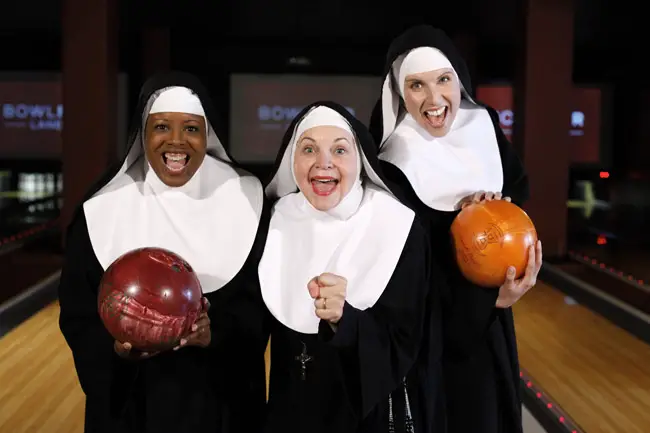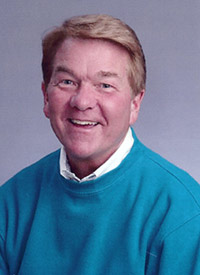
Many things about growing up Catholic could make life complicated. To artists, the more complicated a problem, the more creative a solution. At least that’s been the experience of Danny Goggin, creator and director of “Nunset Boulevard: The Nunsense Hollywood Bowl Show,” which comes to the Flagler Auditorium Tuesday (Dec. 4). Goggin is also the creator of the rest of the Nunsense series, critically acclaimed since its first apparition as a little musical number in a Greenwich Village cabaret in the earliest years of the Reagan administration.
It was actually a mannequin that inspired Goggin to conceive what would eventually become Nunsense—a mannequin, in a nun’s habit, that is. A friend and former theater buddy who happened to be a Dominican Brother—a friar within the Catholic Dominican Order who is not actually a priest—came into possession of a nun’s habit as the church began to modernize after the Second Vatican Council in the 1960s, and nuns were no longer required to wear their iconic black drapes, also known as religious habits. He dressed the dummy and sent it to Goggin as a gag.
“He said, ‘This Dominican Sister is a gift for the man who has everything,’ which of course I didn’t,” Goggin said. Well, he certainly didn’t have one of those. The mannequin quickly became popular in Goggin’s social circle, so he even started putting it on greeting cards. “People began to like her more than me, so I said, ‘I need to write a story about this character.’”
This anecdote should prepare anyone for the zany nature of the Nunsense plot over its seven shows. “Nunset Boulevard” is as nutty as any of the others, Goggin says. The sisters of Hoboken, who should be known to audiences from a Nunsense genealogy almost as long as Abraham’s—Nunsense, Nunsense 2, Nunsense Jamboree, Nuncrackers, Meshuggah Nuns, Nunsensations—have been invited to sing at the Hollywood Bowl. As it turns out, what they anticipated to be the famed Los Angeles amphitheater is in fact the Hollywood Bowl-A-Rama—a bowling alley. Now the sisters must contend with all the ambient noises of bowling alleys—loud announcements, pins crashing, squeals. Things go from silly to ridiculous when the sisters overhear that the famous movie producer James Todd is across the street auditioning for roles in his new movie musical about the real Hollywood actress turned nun, Dolores Hart: “Nunset Boulevard: A Song from the Hart.” Of course, each of the sisters thinks she’s a natural for the role and rushes over there.
Hart, in real life, before she decided to shock the world by becoming a cloistered Benedictine nun, had starred opposite some of the biggest actors of the 1950s including Anthony Quinn, Myrna Loy, and Montgomery Clift. She even had the privilege of being one of Elvis Presley’s first onscreen kisses. Nunset Boulevard was funny enough to make the former starlet, now Mother Superior, laugh when she attended the show in person. She wrote Goggin a “real money” letter, a personal thank you on Abbey stationary that sounded like a raving critic’s review. Because Goggin was so moved by her support for the show, half the profits from the DVD go the Abbey of Regina Laudis, Hart’s home.

The five sisters’ characters in the show are based on the five nuns who taught Goggin while he was growing up. The real life Mother Superior, who is played by Cindy Williams, best known as Laverne from the hit 70s sitcom Laverne and Shirley, would always take pride in telling the other nuns that she was the star of the show.
Naturally, you don’t have to be Catholic to enjoy the show. Nor do you have to have seen the other shows to enjoy it. Goggin writes each installment as a stand-alone. But if it encourages people to backtrack and see previous installments, so much the better. As far as cultural or artistic merits go, Goggin says, “The show is about no more than lifting the human spirit, making the audience feel better when they leave the theater than when they came in.”
On the other side of the spectrum, one challenge in writing an irreverent musical comedy about nuns is how to do it without offending anyone, particularly the nuns themselves, or Catholic sensibilities. Judging by the response of Dolores Hart and the nuns who saw to Goggin’s development into a proper young man, it seems he was successful there as well. “I think the thing is I know where to draw the line because I was around them. I’ve seen them when they’re not trying so hard to be holy in front of other people, when they’re at ease. Also, you can always get away with double entendre. As long as there are two ways to take a joke, if you think up the dirty side of it, that’s your problem.
“People ask me all the time how do I keep laughing at my own material which I’ve been watching for three months straight,” Goggin says. “The reason is it’s never the same show.” That is, although, everything is planned and structured, “it’s what’s called a presentational show in real time. The cast interacts with the audience.” One example in Nunset of cast-audience improvisation is when audience members get the opportunity to come to the stage and bowl a turkey down one of the lanes for prizes. In one show, an audience member bowled the turkey overhand and almost took out one of the Sisters. “You never know what someone might say or do up there.”
The type of humor in Nunsense is most similar to that of the iconic “I Love Lucy” show, Goggin says, in that the situations that arise are absurd but somehow, someway, still believable enough to be funny. That’s not the only thing he’s taken away from the Lucy and Desi model. “When Lucy and Ricky went to Hollywood, that opened up a whole new set of stories. That’s what we’re trying to do here with the Sisters. I said, maybe the Hollywood thing would be fun to do.”
Incidentally, Goggin knows someone who knows someone who knew Vivian Vance, who played Ethel Mertz in “I love Lucy,” who told him that Vance would’ve absolutely loved to play the Mother Superior in Nunsense.
Goggin began his career in show business as a singer and was in the Broadway production of Luther with Albert Finney. He wanted a record contract but was told that if he didn’t write original material it would be very difficult to get. So he was forced into writing.
“When Nunsense began, it was much simpler, just a cabaret,” Goggin says. He planned for the show to go four weekends, but it was so successful it went 38 weeks. Before he could get it running nationally, the producers demanded that he flesh out the story, so what would be the complete show didn’t open until 1985. It was voted Best Broadway Musical that year and continued to run for 10 years. Five years into it, Goggin began to write sequels, which also started running all over the country. All in all, the Nunsense shows have pulled in half a billion dollars over that period, Goggin says, though the theaters get to keep most of that money, similar in some ways to the monetary relationship between Sisters and Brothers in the Catholic Church.
![]()
Danny Goggin’s “Nunset Boulevard: The Nunsense Hollywood Bowl Show,” Starring Cindy Williams. In performance for one night only, Tuesday, Dec. 4 at 7:30 p.m. at the Flagler Auditorium. Tickets are $39 for adults, $28 for youths. Call the Auditorium box office at 437-7547 or visit the auditorium’s website.





























Leave a Reply